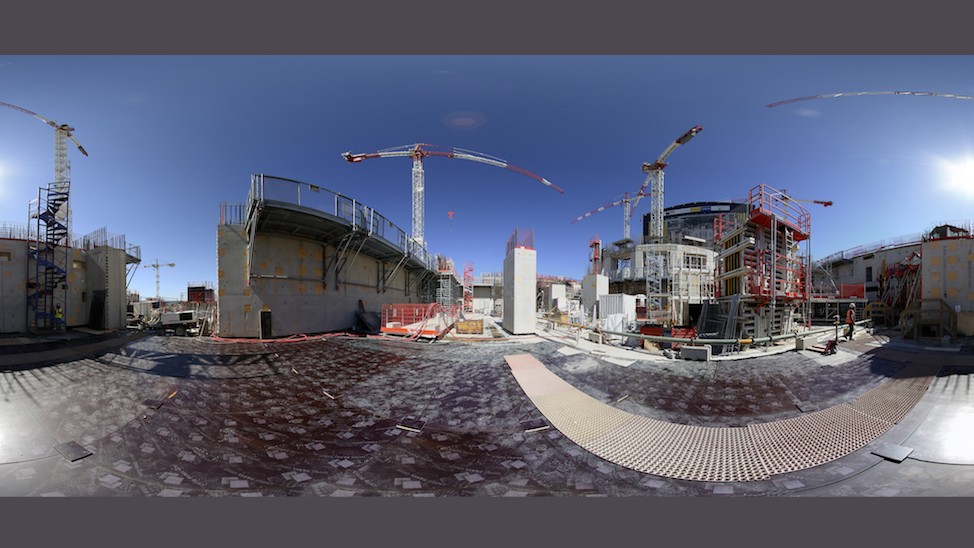Fusion experiment smashes record for generating energy, takes us a step closer to a new source of power
The Joint European Torus fusion reactor released a record-setting 59 megajoules of energy.

An experimental nuclear fusion project has set a world record in generating energy on Earth using the same kind of reactions that power the sun.
In the new experiments, the Joint European Torus (JET) in Culham near Oxford, England, produced blazingly hot plasmas that released a record-setting 59 megajoules of energy — about the same amount of energy unleashed by the explosion of 31 pounds (14 kilograms) of TNT.
Nuclear fusion — the same reaction that occurs in the heart of stars — merges atomic nuclei to form heavier nuclei. Nuclear physicists have long sought to produce nuclear fusion in reactors on Earth because it generates far more energy than burning fossil fuels does. For example, a pineapple-size amount of hydrogen atoms offers as much energy as 10,000 tons (9,000 metric tons) of coal, according to a statement from the International Thermonuclear Experimental Reactor (ITER) project.
Related: 5 sci-fi concepts that are possible (in theory)
The new experiments at JET are designed to help pave the way for ITER, which aims to create the world's first nuclear fusion plant. ITER is currently under construction in southern France, and is intended to release 10 times more energy than goes into it to trigger fusion.
"It took us years to prepare these experiments. And in the end we have managed to confirm our predictions and models," Athina Kappatou, a physicist at the Max Planck Institute of Plasma Physics in Garching near Munich, Germany, told Live Science. "That's good news on the way to ITER."
JET, which began operating in 1983, now uses the hydrogen isotopes deuterium and tritium as fuel. Whereas a normal hydrogen atom has one neutron in its core, a deuterium atom has two neutrons and a tritium atom has three. Currently, it is the only power plant in the world capable of operating with deuterium-tritium fuel — although ITER will also use it when it comes online.
Get the Space.com Newsletter
Breaking space news, the latest updates on rocket launches, skywatching events and more!
Previous research found that of all the possible fuels for nuclear fusion, the combination of deuterium and tritium fuses the most easily and at the lowest temperature. Only deuterium-tritium fusion is predicted to release enough energy under realistically achievable conditions to create surplus electricity.
However, deuterium-tritium fusion poses a number of challenges. For example, deuterium-tritium fusion can generate dangerous amounts of high-energy neutrons, each moving at about 116 million mph (187 million km/h), or 17.3% the speed of light — so fast they could reach the moon in under 8 seconds. As such, special shielding is needed in these experiments.

For the new experiments, the previous carbon lining in the JET reactor was replaced between 2009 and 2011 with a mixture of beryllium and tungsten, which will also be installed in ITER. This new metallic wall is more resistant to the stresses of nuclear fusion than carbon, and also clings onto less hydrogen than carbon does, explained Kappatou, who prepared, coordinated and led key parts of the recent experiments at JET.
"The installation of a new wall required high precision and care," Kappatou said. "A huge robotic arm with remote control was used in the JET vessel for this purpose."
Another challenge with deuterium-tritium fusion experiments is the fact that tritium is radioactive, and so it requires special handling. However, JET was capable of handling tritium back in 1997, Kappatou noted.
Also, whereas deuterium is abundantly available in seawater, tritium is extremely rare. For now, tritium is produced in nuclear fission reactors, although future fusion power plants will be able to emit neutrons to generate their own tritium fuel.
JET set the previous world record for energy generated from nuclear fusion in 1997 with plasmas that produced 22 megajoules of energy. The new experiments generated plasmas that produced more than double that amount of energy using just six millionths of an ounce (170 micrograms) of deuterium-tritium fuel.
"In comparison, producing that much heat energy takes 1.06 kilograms [2.34 pounds] of natural gas or 3.9 kilograms [8.6 pounds] of lignite coal, a factor 10 million more," Kappatou said.
In January, scientists at the National Ignition Facility in California revealed that their laser-powered nuclear fusion experiment generated 1.3 megajoules of energy for 100 trillionths of a second — a sign the fusion reaction generated more energy from nuclear activity than went into it from the outside. "Their work, and that of many other public and private groups, does show a great and growing worldwide appetite to achieve fusion energy," Kappatou said.
The copper electromagnets that JET used could only operate for about 5 seconds due to the heat from the experiments. "JET simply wasn't designed to deliver more," Kappatou said. In contrast, ITER will use cryogenically cooled superconducting magnets that are designed to operate indefinitely, the researchers noted.
ITER aims to start its own deuterium-tritium experiments in 2035. The most recent JET experiments will help inform this future work, Kappatou said.
"We have generated a huge amount of data from the operation," Kappatou said.
Originally published on Live Science.
Join our Space Forums to keep talking space on the latest missions, night sky and more! And if you have a news tip, correction or comment, let us know at: community@space.com.

Charles Q. Choi is a contributing writer for Space.com and Live Science. He covers all things human origins and astronomy as well as physics, animals and general science topics. Charles has a Master of Arts degree from the University of Missouri-Columbia, School of Journalism and a Bachelor of Arts degree from the University of South Florida. Charles has visited every continent on Earth, drinking rancid yak butter tea in Lhasa, snorkeling with sea lions in the Galapagos and even climbing an iceberg in Antarctica. Visit him at http://www.sciwriter.us










